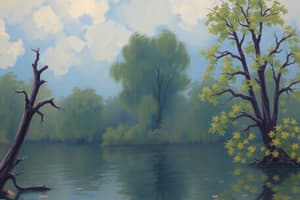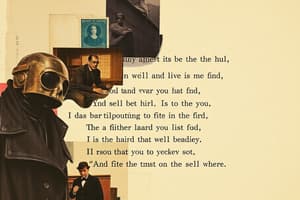Podcast
Questions and Answers
The oldest surviving poem is the Epic of ______, which has an unknown origin.
The oldest surviving poem is the Epic of ______, which has an unknown origin.
Gilgamesh
A ______ is a group of lines forming a basic metric unit of a poem.
A ______ is a group of lines forming a basic metric unit of a poem.
stanza
A couplet consists of ______ lines that usually rhyme.
A couplet consists of ______ lines that usually rhyme.
2
The pattern of sounds that repeats at the end of lines is known as a ______ scheme.
The pattern of sounds that repeats at the end of lines is known as a ______ scheme.
______ is the beat and pace of a poem, defined by stressed and unstressed syllables.
______ is the beat and pace of a poem, defined by stressed and unstressed syllables.
A ______ is a stressed syllable followed by an unstressed syllable.
A ______ is a stressed syllable followed by an unstressed syllable.
The poem's ______ affects the reader's experience through the vocabulary and figurative language used.
The poem's ______ affects the reader's experience through the vocabulary and figurative language used.
Figurative language goes beyond literal meanings, using devices such as simile and ______.
Figurative language goes beyond literal meanings, using devices such as simile and ______.
Flashcards
What is Poetry?
What is Poetry?
Literature that uses language in a specific way to evoke emotions and experiences in the reader. It focuses on meaning, sound, and rhythm.
What is a Stanza?
What is a Stanza?
A group of lines in a poem that act as a building block, often with a specific structure, rhyme, and mood.
Couplet
Couplet
A stanza with only two lines, always rhyming with each other
What is Rhyme in Poetry?
What is Rhyme in Poetry?
Signup and view all the flashcards
What is Rhythm in Poetry?
What is Rhythm in Poetry?
Signup and view all the flashcards
What is Meter in Poetry?
What is Meter in Poetry?
Signup and view all the flashcards
What is Tone in Poetry?
What is Tone in Poetry?
Signup and view all the flashcards
What is Figurative Language?
What is Figurative Language?
Signup and view all the flashcards
Study Notes
Poetry
- Literature that uses language to evoke a concentrated imagination of experiences and feelings.
- Language is carefully chosen for its meaning, sound and rhythm.
- Examples include the Epic of Gilgamesh, which is the oldest surviving poem.
- Gilgamesh was a king of Uruk.
Elements of Poetry
a. Stanza
- A group of lines that form a unit within a poem.
- Purpose: structure, pattern (rhyme), organisation (explore thought), setting a mood, using symbolism.
- Types:
- Couplet (2 lines, with rhyme)
- Tercet (3 lines, 1st & 3rd line rhyme)
- Quatrain (4 lines)
- Cinquain (5 lines)
- Sestet (6 lines)
- Septet (7 lines)
- Octave (8 lines)
b. Rhyme
- A rhyme scheme is the pattern of repeated sounds at the end of lines or stanzas.
- The rhyme scheme can be different within a single poem, and change across lines or stanzas (alternate rhyme) or throughout the whole poem.
c. Rhythm
- The beat and pace of a poem.
- It can be a pattern of stressed and unstressed syllables.
- Associated with meter, the units of stressed and unstressed syllables.
d. Meter
- A pattern of stressed and unstressed syllables.
- Includes examples like Lamb, Trochee, Dactyl, Anapest, Spondee, and Pyrrhic.
e. Tone and Mood
- The writer's viewpoint toward the poem's contents (subject, speaker, or audience).
- Often described by the mood that is created in a reader.
- Interpretation is created by vocabulary, rhymes, and figurative language.
f. Figurative Language
- Words are not used literally, but create more impact.
- Creates meaningful imagery
- Includes examples of similes, metaphors, allusion, alliteration, imagery, and onomatopoeia.
Studying That Suits You
Use AI to generate personalized quizzes and flashcards to suit your learning preferences.




